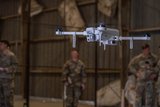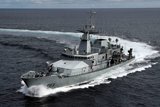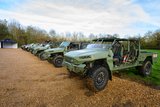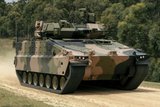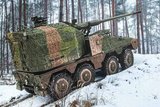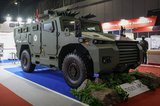Lasers are coming, but are personnel protected?
The US Army’s recent tests of high-energy laser systems, including on the Stryker combat vehicle, illustrates a potential problem with their use; the safety of personnel exposed to them.
Though counter-UAS tests have been reportedly effective, demonstrations have been limited by the need to ensure all engagements are below-the-horizon so as not to risk blinding nearby aircraft.
Coming with such limitations is uneven recognition that effective training with – and fighting against – tactical laser systems will require protecting the eyes of those in contact with them.
'As more laser threats emerge, we’re being asked to design eyewear
Already have an account? Log in
Want to keep reading this article?
More from Land Warfare
-
![Team LionStrike polishes British Army vehicle offering for Land Mobility Programme]()
Team LionStrike polishes British Army vehicle offering for Land Mobility Programme
Team LionStrike has demonstrated its offering for the British Army’s Land Mobility Programme with plans to bid the Chevrolet Silverado and two variants of the platform: the Infantry Squad Vehicle and General Support Utility Platform.
-
![South Korean companies turning necessity into export opportunity]()
South Korean companies turning necessity into export opportunity
South Korea’s particular geopolitical situation and threat environment has created a defence industry ecosystem of substantial size and breadth.
-
![“A new philosophy of defence”: ASELSAN sets out ambitions for the future]()
“A new philosophy of defence”: ASELSAN sets out ambitions for the future
In Conversation: Shephard’s Gerrard Cowan talks to ASELSAN CEO and President Ahmet Akyol about how the business has evolved and expanded over the past five decades, and its aim of becoming a top 30 global defence company by 2030.
-
![Still no clarity on the future of the British Army’s new wheeled artillery system]()
Still no clarity on the future of the British Army’s new wheeled artillery system
The UK donated its AS90 155mm/39cal tracked self-propelled howitzers to Ukraine ahead of planned retirement and bought Archer platforms to fill the gap. Eventually RCH 155s were ordered but the procurement effort remains under a cloud.
-
![More details of Indonesia’s Celeris-based 4x4 emerge as customer hunt begins]()
More details of Indonesia’s Celeris-based 4x4 emerge as customer hunt begins
The Texelis Celeris builds on the rolling chassis of the Serval 4×4 lightweight multi-role armoured vehicle which is being built by Texelis and Krauss-Maffei Wegmann Nexter Defence Systems (KNDS France).
-
![KF41 Lynx finds a path but hurdles remain]()
KF41 Lynx finds a path but hurdles remain
The Lynx is typically configured as an IFV operated by a crew of three and with space for up to eight dismounts in the rear troop compartment. The platform is being delivered to Hungary, has been contracted for Italy and will soon be in Ukrainian hands in small numbers.







